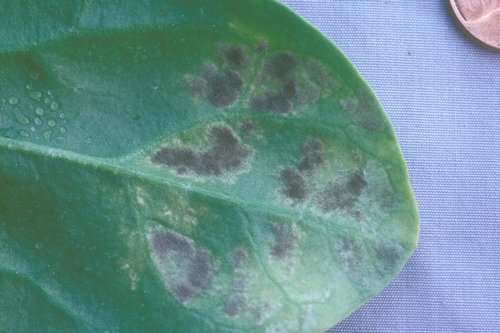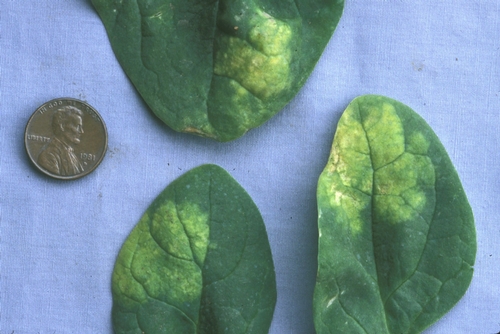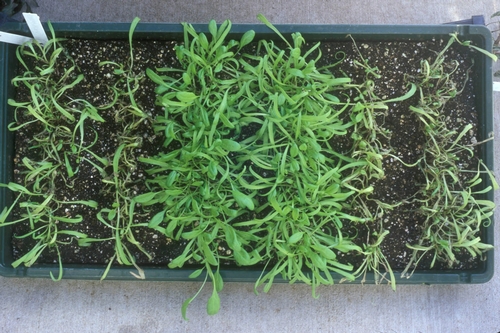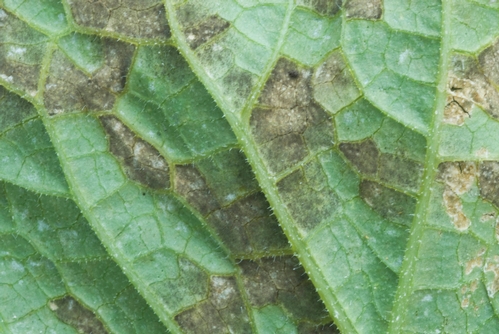- Author: Jim Correll, University of Arkansas Steven Koike, University of California Cooperative Extension
Another new race, the 13th, of the downy mildew pathogen (Peronospora farinosa f. sp. spinaciae) of spinach has been found and documented. First identified in January 2010 from spinach in Holtville, California, this race breaks the resistance of several important cultivars. The isolate was initially designated as UA0510C and was characterized with a standard set of differential varieties. Isolates apparently identical to UA0510C have been found in an increasing number of locations throughout California in 2010 and 2011. After careful evaluation of the significance of this development to the spinach industry, the International Working Group on Peronospora (IWGP) has designated this isolate as race Pfs 13. The IWGP is located in The Netherlands and is administered by Plantum NL.
Race Pfs 13 poses a threat to the spinach industry because it is particularly well-adapted to modern hybrids with resistance to races 1-12. The appearance of a new race is not unexpected because hybrids with resistance to races 1-12 have been widely planted over the past few years. Similar developments have taken place when races Pfs 5 (1996), Pfs 6 (1998), Pfs 7 (1999), Pfs 8 and 10 (2004), Pfs 11 (2009), and Pfs 12 (2009) were identified and named. The occurrence of Pfs 13 will clearly encourage the industry to develop and use new spinach cultivars having resistance to races 1-13. A history of the detection of the various spinach downy mildew races is presented in Table 1.
A collaboration of researchers with the IWGP, University of Arkansas (Correll), and University of California (Koike) is monitoring the development of new races of spinach downy mildew on a global scale by collecting and testing suspected new isolates. In this way it is hoped that research findings and conclusions will be agreed upon and better communicated between the seed industry, spinach growers, and other interested parties. For California and Arizona, the Correll-Koike team will continue to receive and test spinach downy mildew samples for growers, pest control advisors, and seed companies. Industry is encouraged to continue to submit downy mildew outbreak samples to Correll-Koike, as such samples facilitate the discovery of additional new races. The Correll-Koike research is made possible by support from the California Leafy Greens Research Board and by active participation by the agricultural industries in California and Arizona.
For more information on this subject you can contact Steven Koike (stkoike@ucdavis.edu), Jim Correll (jcorrell@uark.edu), Diederik Smilde (d.smilde@naktuinbouw.nl), or IWGP chairperson Jan de Visser (JandeVisser@popvriendseeds.nl).
Table 1. Races of spinach downy mildew and year of detection
| Year | Race |
| 1824 | 1 |
| 1958 | 2 |
| 1976 | 3 |
| 1990 | 4 |
| 1996 | 5 |
| 1998 | 6 |
| 1999 | 7 |
| 2004 | 8 |
| ... | (9)* |
| 2004 | 10 |
| 2008 | 11 |
| 2009 | 12 |
| 2010 | 13 |
*One time detection only

Downy mildew of spinach is the most important disease on this crop and results in quality and yield losses.
- Author: Jim Correll
- Author: Steven T. Koike
Yet another new race of downy mildew (Peronospora farinosa f. sp. spinaciae) on spinach has been identified in California’s Salinas Valley. The type, or original, strain was initially designated as UA2209 and was first detected in May 2009. Subsequently, it was found in an increasing number of locations throughout California in 2009 and 2010. This race breaks the resistance of several important cultivars. The race has been characterized on a set of differential cultivars and was designated as race Pfs 12 by the International Working Group on Peronospora (IWGP). The working group is located in the Netherlands and is administered by Plantum NL.
Race Pfs 12 poses a threat to the spinach industry because it is particularly well-adapted to most modern hybrids with resistance to race 1-11, which have been widely planted in the past few years. Race 12 is distinct from race 11 because of its virulence on the differentials Campania and Avenger. The appearance of a new race is not completely unexpected because hybrids with resistance to races 1-11 have been planted on a large scale. Similar developments have taken place when races Pfs 5 (1996), Pfs 6 (1998), Pfs 7 (1999), Pfs 8 and 10 (2004), and Pfs 11 (2009) were identified and named. The occurrence of Pfs 12 will create strong interest for Pfs 1-12 resistant spinach cultivars from both growers and breeders.
The IWGP is a working group of Plantum NL consisting of spinach seed companies (Pop Vriend, Monsanto, Rijk Zwaan, Nunhems, Takii, Sakata, Bejo, Enza, Syngenta, Advanseed), Naktuinbouw, and the University of Arkansas. The efforts of the group are supported by research activities at the University of Arkansas and the University of California Cooperative Extension—Monterey County. The aim of the IWGP is to monitor and designate new races of downy mildew in spinach, and to promote a consistent and clear communication between the seed industry, researchers, and growers about all resistance-breaking races that are persistent enough to survive over several years, occur in a wide area, and cause a significant economic impact.
IWGP is monitoring new races continuously by testing field isolates on a fixed, common host differential set of cultivars that contains the full range of available resistances. Researchers all over the world are invited to join the IWGP initiative and use the common host differential set to identify new isolates. For California, the Correll-Koike team will continue to receive and test spinach downy mildew samples for growers, pest control advisors, and seed companies.
For more information on this subject you can contact Steven Koike (stkoike@ucdavis.edu), Jim Correll (jcorrell@uark.edu), Diederik Smilde (d.smilde@naktuinbouw.nl), or IWGP chairperson Jan de Visser (JandeVisser@popvriend.nl).

Downy mildew is the most damaging disease of spinach in California and causes yellow and tan leaf lesions.

To identify downy mildew races, a series of spinach cultivars is grown and inoculated; races are identified based on which cultivars become diseased.
- Author: Steven T. Koike
- Author: Robert L Gilbertson
In spring and summer of 2010, plants in some tomato and pepper fields in coastal California have developed virus-like symptoms. Affected plants were found in both Monterey and San Benito counties, though disease incidence was low. Samples submitted to the Gilbertson lab at UC Davis tested positive for the curly top virus, indicating that these symptoms were due to curly top disease.
Curly top can be a severe disease for both tomato and pepper. Symptoms of the disease vary depending on the host plant infected and the stage of growth when infections occur. In general, affected plants show some degree of stunted and distorted growth and leaf curling and light green to yellow discoloration. In tomato, curly top symptoms begin with leaves showing light green coloration, up-curling, and vein purpling on the underside of leaves. Plants become stunted with twisted, distorted, and yellow leaves. Plants infected at an early stage of development stop growing and die, often standing out among nearby healthy plants. Plants infected at later stages of development show distorted growth and light green-yellow leaves with vein purpling; these symptoms will develop on the upper part of the plant or on entire shoots, but the plants generally do not die. Any fruits produced will be stunted and ripen prematurely.
In peppers, plants are stunted with shortened internodes. Leaves are light green or yellow in color, show strong up-curling, and are thick and brittle. Plants infected at a young stage of growth may die, whereas older plants are stunted and leaves again curl upwards and are light green to yellow; any fruits that develop are small, wrinkled, and unmarketable. As for all diseases caused by viruses, confirmation of curly top disease requires laboratory testing because other tomato and pepper viruses can cause symptoms that are similar to those caused by the curly top viruses (e.g., symptoms caused by Tomato spotted wilt virus).
In California curly top disease affects many plants including tomato, pepper, bean, pumpkin, squash, spinach, sugar beet, other crops, and many weeds. Researchers have discovered that curly top disease in the western USA is actually caused by several distinct virus species. Therefore, curly top of tomato or pepper could be caused by one or more of the following viruses: Beet curly top virus (BCTV), Beet mild curly top virus (BMCTV), Beet severe curly top virus (BSCTV). For example, samples in 2008 from Monterey County tested positive for either BMCTV or BSCTV.
The curly top viruses are vectored by the beet leafhopper (Circulifer tenellus). The virus is not carried in seeds nor is it mechanically transmitted (i.e., by touch or physical contact). Disease incidence and distribution in tomato and pepper fields in a given year are dependent on the populations of the beet leafhopper and the migratory feeding patterns of this insect. Most infections tend to occur early in the growing season, but late season infections may also occur, as in 2010. In general, for coastal California, disease incidence is usually low and symptomatic plants occur randomly in a field, indicating where the fast moving leafhopper has stopped to feed. The random, scattered distribution of diseased plants reflects the fact that tomato and pepper are not preferred hosts of the beet leafhopper and that the insects move on in search of preferred hosts, such as plants in the beet family (Chenopodiaceae).

Tomato infected with curly top viruses: If infected early, plants can be severely stunted.

Tomato infected with curly top viruses: Leaves can be thickened, deformed, yellowed, and rolled upwards. Symptomatic tomato leaves often develop purple veins.

Pepper infected with curly top viruses: If infected early, plants can be severely stunted.

Pepper infected with curly top viruses: Leaves can be thickened, deformed, and rolled upwards.
- Author: Richard Smith
In 2008 we received a 24C for use of Dual Magnum on spinach; however, two issues make the current version of the label difficult to use: 1) the plant back interval for lettuce is 12 months which seriously limits its utility in Salinas Valley rotations, and 2) the preharvest interval (PHI) is 50 days. The plant back issue is still not resolved; however progress was recently made on the PHI.
The IR4 program conducted residue studies to change the PHI to 21 days. We just received news about the residue trials: Dual Magnum residues collected at this interval exceeded the current tolerance and a 21 day PHI will not be possible. As a result, Syngenta is currently trying to settle for a PHI of 40 days. This would be an improvement over the current PHI of 50 days, but still leaves Dual Magnum in a grey zone for use on clipped spinach which commonly matures in 30 days or less.
One alternative that we have explored is the application of Dual Magnum prior to planting. The question that comes up is do you lose a certain percentage of the Dual Magnum if it is applied to the top of the bed and it sits for a period of time before being incorporated into the soil with sprinkler irrigation following planting. In San Ardo in 2009 we conducted a trial in which Dual Magnum was applied to shaped beds on July 1 and the field was planted on July 21. We observed good efficacy at the 0.75 and 1.0 pint rates (Table 1). There was little efficacy at the 0.50 pint/A rate when the Dual Magnum remained on the soil surface for 21 days prior to planting; normally we see reasonable weed control at the 0.50 pint/A rate when Dual Magnum is applied immediately following planting and incorporated into the soil with sprinkler irrigation. It therefore appears that Dual Magnum can remain on the soil surface for at least 20 days, but higher rates may need to be used to obtain weed control equivalent to what is needed for at-planting applications. We will need further evaluations of this application technique to better understand the rates and timing.
Table 1. Weed counts and phytotoxicity rating on August 6, 2009
|
Treatment |
Material |
Lbs a.i./A |
Purslane |
Malva |
Other weeds |
Total weeds |
Phyto |
|
Dual Magnum |
0.50 pint |
0.48 |
41.3 |
0.8 |
1.3 |
43.3 |
0.0 |
|
Dual Magnum |
0.75 pint |
0.72 |
4.0 |
1.8 |
2.3 |
8.0 |
0.8 |
|
Dual Magnum |
1.00 pint |
0.96 |
1.0 |
2.8 |
4.3 |
8.0 |
1.3 |
|
Untreated |
---- |
---- |
3.0 |
11.8 |
21.8 |
36.5 |
0.0 |
|
Pr>Treat |
|
|
<0.001 |
<0.001 |
<0.001 |
0.002 |
0.005 |
|
LSD 0.05 |
|
|
16.4 |
3.7 |
5.7 |
17.0 |
0.7 |
- Author: Steven T. Koike
The cucumber crop in central coast California is a minor crop, with only a modest acreage planted annually. However, a major disease threatens this commodity that is grown both out in the field and inside greenhouses. In recent years, a very aggressive, destructive strain of downy mildew (the pathogen is Pseudoperonospora cubensis) has devastated cucumber plantings. Leaves first develop angular shaped lesions that turn yellow. Later, the tissue in these lesions dies and becomes brown (photo 1). In most cases the diagnostic purple gray mycelium and spores develop on the leaf undersides (photo 2). As disease progresses, entire leaves decline and the plants collapse due to severe infection. Downy mildew also infects squash and watermelon, though this current problem is most problematic on cucumber.
California growers are hardly alone in this situation. Last year the aggressive downy mildew damaged cucumber crops in various parts of the USA, along the eastern seaboard stretching from New York down to Florida, and from there extending west as far as Wisconsin, Illinois, Missouri, Louisiana, and Texas. For California, downy mildew was reported on production cucumber in the central coast and other regions, and on seed cucumber crops in the upper San Joaquin Valley.
Management of this apparently new cucumber strain is difficult. Organic producers have few options because protectant sprays do not appear to help, and suitable resistant cultivars have not yet been identified. For conventional growers, early preventative sprays should be made (see the UC IPM website: http://www.ipm.ucdavis.edu/PMG/r116101611.html). This cucumber situation is yet another case illustrating how this group of pathogens is able to change and cause problems for growers. Central coast growers are already very familiar with the new races and aggressive outbreaks of lettuce and spinach downy mildews.
Plant Pathologist Steven Koike is monitoring the California cucumber situation and is collaborating with researchers in Michigan and North Carolina. He is interested in hearing about downy mildew outbreaks on cucumber in California (phone 831-759-7350; stkoike@ucdavis.edu).
Photo 1: Angular lesions on cucumber caused by downy mildew.
Photo 2: Downy mildew lesions support the purple growth of the pathogen.


